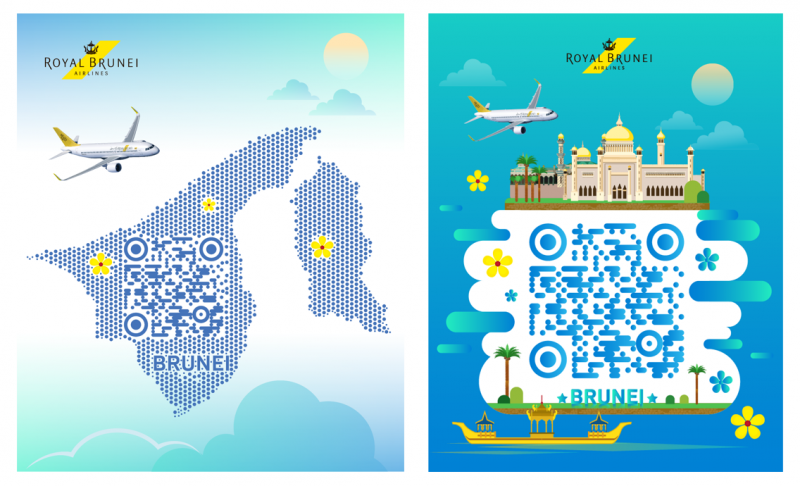Last year, we wrote about why QR codes are so important and commonly used in China, with examples of some of the best and most creative QR code designs that are being used by travel brands. As an update to that article, we’ve put together four suggestions for how QR codes can be used in the context of Chinese tourism, together with a new collection of our favorite QR codes.
1. Social Media
Travel brands will often include a QR code at the end of their WeChat posts. These QR codes could link to a website or mini-program, so that the reader could easily access more information about the destination or business. Why a QR code instead of a simple link to a website? Actually, external links cannot be included in WeChat articles published by subscription accounts, so a QR code is a great workaround if you do want to send readers to a website. But many travel brands’ QR codes at the end of a WeChat article tend to open that brand’s WeChat account instead. What is the point of this if the reader is already reading an article from your account? Quite simply, it helps new WeChat users to follow you. Let’s say that they’re reading the article not because they follow your account already, but because a friend sent it to them on WeChat, or shared it on WeChat Moments, or they are seeing it because of a paid promotion on WeChat. After they read the article, a QR code at the bottom encourages them to start following the account in an eye-catching way, and makes it easier to follow – otherwise, they would need to scroll all the way up to the start of the article and click on the account name to do so.

It is standard for travel brands to include their QR codes at the end of WeChat articles
2. Advertising
Putting QR codes in your advertising – either online or offline – makes it incredibly easy for Chinese consumers to get more information about your brand, by visiting your Chinese website or following you on social media. So if you buy a banner ad on a Chinese website, or a print advertisement in an in-flight magazine, or have a poster at an airport, or displayed somewhere in a Chinese city, or at a travel event, you’ll want to put your QR code there.
3. In-Destination
You can also use QR codes in-destination, and there are a couple of different ways that this can work. Let’s say you’re a museum. By displaying your QR code at the airport or tourist information office of the city where you’re located, you make yourself more visible to Chinese tourists, who may then be more likely to visit. Once they’re already at your museum, you can then use QR codes on various museum displays, for visitors to scan and get more information in Chinese about what they are looking at. This QR code could link to the museum’s mini-program, which can serve as either a written or audio guide, or combine elements of both. There are numerous advantages to this approach. First of all, you avoid having to include written information in multiple languages on displays. Second, since the information will be hosted on a digital platform, it can be more easily updated than a written display or brochure. Third, you don’t have to worry about distribution issues, like running out of flyers or Chinese visitors not noticing your printed guides at the entrance to the museum. Fourth, it gives Chinese visitors information to enhance their experience in the way that is most comfortable and convenient to them – on their mobile phones. And finally, it makes it much easier for the visitors to share your mini-program or WeChat account with their contacts if they enjoy their visit, helping you to achieve invaluable word-of-mouth marketing.
4. Reputation Management
In the last section, we used the example of a museum. But what about if you’re a restaurant, shop, hotel, or other kind of attraction? In this case, QR codes can be displayed to ask Chinese visitors to leave a review for you on a Chinese platform such as Mafengwo, Qyer, or Dianping. One recent study has shown that Chinese travelers are actually more likely to use and more trusting of recommendations they find on these word-of-mouth platforms than recommendations given to them in-person by locals, so building up a presence on review sites can make a huge difference when it comes to attracting Chinese clientele. Learn more in our guide to leveraging word of mouth marketing, or by watching our webinar on reputation management.
Great QR Code Design for Travel Brands

The Getty Center’s QR code suits an art museum with its watercolor-style design, and the irises at the bottom are a nod to Van Gogh’s famous painting at the museum. Scanning the code connects you to the Getty Center’s WeChat account. (Design by Dragon Trail)

Visit Argentina’s QR code includes a variety of things that the country is famous for, from tango and football, to steak and wine. Scanning the code takes you to Argentina’s WeChat account. (Design by Dragon Trail)

Royal Brunei Airlines’ QR codes reflect the brand’s colors and Brunei as a destination. Scanning the codes takes you to Royal Brunei Airlines’ WeChat account. (Designs by Dragon Trail)

Panama’s colorful QR code is designed to look like the Panama Tourism Board’s logo. Scanning it takes you to Panama’s WeChat account. (Design by Dragon Trail)
If you are interested in having a unique QR code designed for your travel brand by the Dragon Trail Interactive team, please contact us at communications@dragontrail.com
Sign up for our free newsletter to keep up to date on our latest news
We do not share your details with any third parties. View our privacy policy.
This website or its third party tools use cookies, which are necessary to its functioning and required to achieve the purposes illustrated in the cookie policy. If you want to know more or withdraw your consent to all or some of the cookies, please refer to the cookie policy. By closing this banner, scrolling this page, clicking a link or continuing to browse otherwise, you agree to the use of cookies.